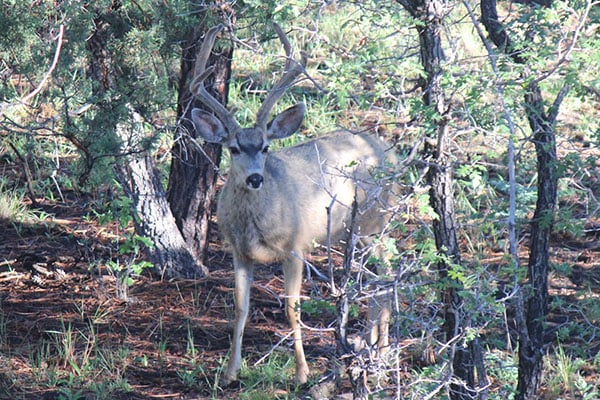
Last Updated on
By Tony Martins
The magnificent mule deer is indigenous to western North America, ranging from central Mexico to the Yukon Territory in Canada, and from the Pacific Ocean as far east as Kansas and Nebraska. This medium-sized but large antlered deer is an iconic symbol of the American West, and one of the most highly prized big game animals on the continent. It’s often said that the mule deer is the most difficult animal for a hunter to place in the celebrated Boone & Crockett record book, due to their keen senses (particularly hearing and night vision) and awareness of their surroundings, as well as the ruggedness of the habitat in which they live. After more than 50 years hunting and observing them, I tend to agree. There is truly something special about these deer with the foot-long ears. Despite the relative commonness of mule deer within their range, a close encounter with a giant antlered, mature muley buck in the wild is so rare that it’s almost mystical – an experience that is certain to be cherished by hunters and non-hunters alike.
Collectively, mule deer can be divided into two main groups – the black-tailed deer, which include the Sitka blacktails and Columbia blacktails of the Pacific coast, and the mule deer group, which includes the Rocky Mountain and Desert varieties as well as California, Southern, Peninsula and Tiburon Island sub-species. Although all will hybridize, black-tailed deer and mule deer (which appear genetically to have evolved from blacktails) are often treated as separate species. This big game profile will focus on the more widespread and numerous mule deer group.
Habitat, Forage and Movement
Mule deer inhabit a variety of habitats, including alpine meadows, sparsely wooded mountains and foothills, rolling prairies and seemingly desolate brushlands as well as desert scrublands, at elevations from sea level to more than 14,000 feet. They prefer drier, more open terrain than blacktails or whitetails, and are uniquely adapted to arid and semi-arid, as well as rocky environments. They thrive in habitats with extensive and diverse shrub growth, good variety in resident plant life, and particularly where young, nutritious plants are emerging. This last fact explains why muleys are often found foraging in recently burned areas. Desert mule deer have adapted successfully to harsh environmental conditions, including temperature extremes of intense heat and brutal cold, scarce water, meager forage and sparse vegetative cover.
Like elk and cattle, mule deer are ruminants, meaning that after feeding they will regurgitate partially fermented stomach contents and chew this “cud” mixture to further aid nutrient extraction and its digestion. The mule deer rumen (first chamber of the stomach) is much smaller than the rumen of elk and cattle however, so muleys are unable to ingest massive quantities of low-quality forage to gain adequate nutrition like elk and cattle. This helps to explain why mule deer require higher quality and more diverse forage than their herbivorous competitors. It also explains why they don’t inhabit old-growth forests (except transitionally), and also fare poorly during drought conditions when native plant communities are less productive. In spring and summer, mule deer rely heavily on willow, oak and juniper, bitterbrush, alpine fireweed, fescue grass, bluegrass and wheat grass. They browse on buds, twigs, leaves and bark, as well as a variety of seasonal forbs. The fall and winter diet includes bitterbrush, mountain mahogany, cliffrose, buckthorn, Russian thistle and sagebrush, as well as juniper berries, acorns, mushrooms and mistletoe when available. Most feeding occurs early and late in the day, although a perceived increase in human activity may cause a shift in behavior to night time feeding.
Although most mule deer migrate between summer and winter ranges, some will spend their entire lives within a comparatively small home range. Researchers in Wyoming used radio collars recently to track a group of mule deer on a 150 mile migratory route – from the high western desert winter range to the mountain meadows and aspen stands where they summer – the longest migration ever recorded for mule deer. Deep winter snow in the mountains forces muleys to lower elevations, usually to foothills or prairies that are kept relatively free of snow by prevailing winds. Desert mule deer will typically winter on sagebrush flats, where the sage provides the bulk of the winter diet.
Mule deer (and blacktails) are known for their pogo-stick fashion of bounding away when alarmed. This stiff-legged gait where all four feet strike the ground simultaneously is called “stotting” and it allows the deer to instantly change direction. This is useful for negotiating uneven terrain, particularly when ascending vertically, and also helps to evade predators. Learning to track mule deer as a youngster, I was often advised by elders when I lost the track that, “mule deer can’t fly.” True… but they can jump really high (clearing 8 feet easily) and really far (measured distance over 30 feet). This makes tracking them through brushlands and foothills quite difficult! And, when disturbed by humans or an influx of natural predators on their home turf, mature mule deer bucks have been known to move 10 miles or more overnight.
Social Interaction and Breeding Behavior
Mule deer and blacktail communication is quite similar to whitetail communication. Fawns make a whiney sounding bawl when frightened or separated from their mothers, and the doe responds with a high-pitched bleat. Fawns will typically remain with the doe until she is ready to give birth the following spring. Does chase their yearling fawns away at this time, but usually allow them to rejoin the family unit after parturition. Bucks grunt while searching for receptive does during breeding season. Both bucks and does alert others to danger with a snort, and the sound of the forcefully exhaled air is like a sharp whistle blast. Foot stomping is another danger alert used by both sexes, and this may be accompanied by a visual signal through flaring of hair on the rump.
From late spring until fall, muleys live in segregated bands – does with fawns and yearlings, and 2-year old and older bucks in more loosely formed bachelor groups. The bands mix when breeding season begins, which may be as early as October depending on region, and extend through January. During winter, several bands may combine to form a small herd, which is led by a dominant doe to the winter range. Some of the largest bucks live alone, and remain solitary until the start of the rut. As rutting begins, bucks rub their antlers on small trees and other brush, to condition themselves for sparring and battles for breeding rights, and to leave visual markings in claimed territory. Their rutting behavior is similar to whitetails, but muley (and blacktail) bucks do not make scrapes. And, while whitetail bucks are relentless in their pursuit of does in estrus, muley bucks are considerably less aggressive in their pursuit. Thus, when hybrids occur where mule deer and whitetail ranges overlap, offspring are almost always the result of a whitetail buck breeding a mule deer doe. Gestation is approximately 190-205 days, with the fawning period extending over several weeks in summer. Does leave their bands to drop their newborn in a secluded location where they remain until strong enough to follow their mothers, usually 7-10 days. First fawns are usually single, while twins are the norm for subsequent births with healthy does. The spotted youngsters are weaned at 60 to 75 days, and begin to lose their spots at this time. Bucks shed their antlers in mid- to late winter, and leave the herd to form bachelor groups in late spring, during transition to summer range.
Hunting Tactics
Most mule deer are taken by hunters using the spot-and-stalk technique. In big western country, this technique would be more properly described as “glass-and-stalk,” where binoculars and/or spotting scopes are used from a vantage point at first and last light to search for deer that are feeding or moving. This technique often involves climbing to the highest point in the hunting area in the dark to be in position for glassing well before sunrise. When a suitable buck is located, most hunters will continue to watch his actions and general direction of movement while planning a stalk. If the buck beds within view as the day brightens, the stalk begins using the topography, brush and boulders to conceal the approach and close the distance for a high percentage shot. Bedded deer tend to watch for danger approaching from below, so stalking from above affords the hunter an advantage. Long-range shooting techniques have been increasingly employed by hunters in the past few years, which eliminates the stealthy stalking requirement, and also a large part of the enjoyment of taking a muley buck, in my opinion.
Still-hunting accounts for a good number of mule deer, and this may be the most popular technique for blacktails taken in forested areas during late seasons. Hunting pressure typically forces muleys into heavy cover, so sneaking along the edges of thickets, brushy stream corridors, and the margins of steep ravines in hilly country can be productive. Muleys have a well-deserved reputation for stopping at the edge of cover or the crest of a hill to look back when they have been spooked. Although wise old muley bucks rarely exhibit this behavior, younger less experienced bucks will often offer this shot opportunity for the alert still-hunter.
Although the daily movement of mule deer is much less predictable than their whitetail cousins making “patterning” more difficult, muleys can be taken with the ambush technique. Ideally, the hunter will position near a saddle between two ridges where deer often travel, or near any other natural funnel. This technique is most effective when deer moving between feeding and bedding areas are intercepted – particularly in agricultural areas – and this is a favored method of bowhunters during early seasons using natural or portable ground blinds for concealment. Muleys are rarely taken by bowhunters from treestands, for a couple of reasons: 1) pinpointing their movement pattern for a close-range shot is exceptionally difficult, and 2) mule deer country holds predators that attack from above, like mountain lions, bobcats and golden eagles. Thus unlike whitetails, muleys look up constantly and will detect even the slightest movement made by a hunter in a tree. Drawing a bow over a mule deer with a successful arrow release is a rare event.
Admittedly not for everyone, my favorite mule deer hunting technique is tracking, and this can be very effective where soil and ground cover permit. Many hunters hunt early and late in the day only, when deer are most active and more easily spotted. I typically hunt all day, using the lower activity time midday to track likely prospects, particularly where heavy cover makes glassing difficult. After locating the track of a mature buck that looks fresh, I follow it until one of 3 things happen: 1) something tells me the track is not fresh – like scat on the trail that is more than 12 hours old, 2) the track is lost, or 3) I catch up with the buck – often relaxed in his bed. This is a close-range hunting technique and for me, it’s the most satisfying and enjoyable way to hunt mule deer. As a result, most of the muley bucks I have taken in more than 50 years of hunting them have come from public land between 10:00 AM and 2:00 PM, when deer are relaxed and most other hunters are not hunting.
Hunting Equipment
The basic equipment for hunting mule deer is much the same as equipment for hunting another western icon that occupies much of the same range: Rocky Mountain elk. In fact, combination hunts for mule deer and elk are popular in several western states. First and foremost on the equipment list is a high quality binocular, and I recommend the best you can afford – as this will pay dividends in terms of minimal eye strain as well as more game spotted during low-light conditions when deer are most active. A light-weight but sturdy tripod with adapter to attach binocular or spotting scope is handy, and can also be used as a shooting rest. If trophy quality is a concern, a good spotting scope will save time, energy and lots of boot leather. A good 800-1000 yard rangefinder is useful in big western country, where long-range shot opportunities may present. Rifle calibers from .243 Winchester to .338 Winchester Magnum shooting bullets that expand rapidly will cover both mule deer and elk. The venerable .270 Winchester and .30-06 Springfield have taken millions of mule deer, with the .280 Remington and .300 Winchester Magnum well represented in the current rankings of mule deer hunters. Whatever rifle and caliber you choose, accuracy is paramount, as mule deer are large animals that can go a long way when wounded.
For comfort, particularly when hunting all day in rugged country, I prefer a light-weight composite rifle stock fitted with comfortable shoulder sling, a light-weight adjustable backpack that fits well, and sturdy boots with ankle and arch support that can be worn comfortably all day in uneven terrain. Finally, while most Desert mule deer hunters will include some type of hydration system among their hunting gear, this important element is often overlooked by mule deer hunters in cooler, mountainous terrain.
Conservation of the Species
While the mule deer has been the most abundant big game animal in the West for more than a century, muley populations have been progressively declining in many parts of their historical range for more than 40 years. Colorado’s mule deer population was estimated to be 625,000 in 1983, but recent estimates put the number around 390,000 – a decline of more than 37%. Similarly, the muley population in Wyoming dropped from an estimated 580,000 to 370,000 (36%) between 1991 and 2012. Wildlife managers, biologists and conservationists have been monitoring this decline with growing concern. Stable and healthy mule deer herds are necessary to support both the hunting industry, and state wildlife agencies that manage same. With fewer mule deer available for harvest, revenue from the sale of hunting licenses and species permits is reduced, with a significant trickle-down effect on the economies of rural communities that host hunters and support their hunting interests.
In 1997, the Western Association of Fish and Wildlife Agencies created a committee of wildlife experts from 17 western states and four Canadian provinces. This “Mule Deer Working Group” (MDWG) was formed to develop strategies to assist in managing the declining mule deer populations, as well as improve communications among wildlife managers and biologists throughout the West. The group’s 2003 landmark publication “Mule Deer: Changing Landscapes, Changing Perspectives” confirmed the decline of mule deer in both numbers and distribution. Although causes were identified as a complex interaction of factors, the group cited “loss and degradation of habitat” that began in the middle of the last century as the single greatest factor.
Following the mule deer population boom of the mid-1950’s, several compounding factors have combined to reduce the amount of viable mule deer habitat as well as the carrying capacity – the number of animals that can be supported by available food, water and cover – of the remaining habitat. This “quiet crisis” that actually began with the settling of the West has developed as a result of these factors:
- Loss and fragmentation of habitat due to, 1) human population growth and rural residential development, and 2) gas, oil and mineral exploration and industrial development in traditional mule deer range.
- Habitat changes caused by fire suppression and subsequent catastrophic fire events, invasive plant proliferation (primarily cheatgrass and pinyon-juniper), and livestock management practices that have all lessened the ability of remaining habitat to support mule deer.
- Climatic changes (primarily drought and severe winter weather) have a negative effect on habitat quality and quantity, lowering reproduction rates as well as survival rates of newborn mule deer.
- Habitat loss, urban sprawl and rural development concentrate mule deer populations on smaller tracts of land and closer to human populations, making these deer more susceptible to predation.
- Deleterious interactions with elk occur more frequently when habitat is poor or limited.
Mule deer need lots of space to thrive, and it’s unlikely their numbers will ever return to the high mark of the 1950’s, given the permanent loss of habitat that has occurred. The challenge of maintaining healthy, huntable mule deer populations is a considerable one moving forward. This can be accomplished, however it will require coordination by wildlife managers and conservationists with considerable cooperation from politicians, industrialists and special interest groups as well as individuals with competing interests and lifestyle choices – and of course, a much needed helping hand from Mother Nature.
Fun Facts About Mule Deer
- Mule deer are named for their large mule-like ears which can move independently, allowing them to survey their surroundings for danger with extraordinary hearing.
- Their unique bounding gait called “stotting” allows them to change direction in a single bound when all 4 hooves strike the ground at the same time.
- Most experts agree that mule deer evolved from blacktails however, the mitochondrial DNA of the mule deer is actually more like the whitetail deer than the black-tailed deer.
- Mule deer often eat dirt. Pregnant and lactating does as well as bucks in velvet do this to obtain minerals like calcium and phosphorous that are necessary for fetal and antler development.
- Muleys have adapted to desert and arid environments, going long periods without water and using their hooves to dig into the ground to reach seep water.
- Although known for living in wide open spaces, adaptable mule deer are increasingly found in urban environments, and mature bucks have been known to move into residential yards.
- Mule deer can’t fly… but they can jump really high (8 feet) and really far (30 feet)!


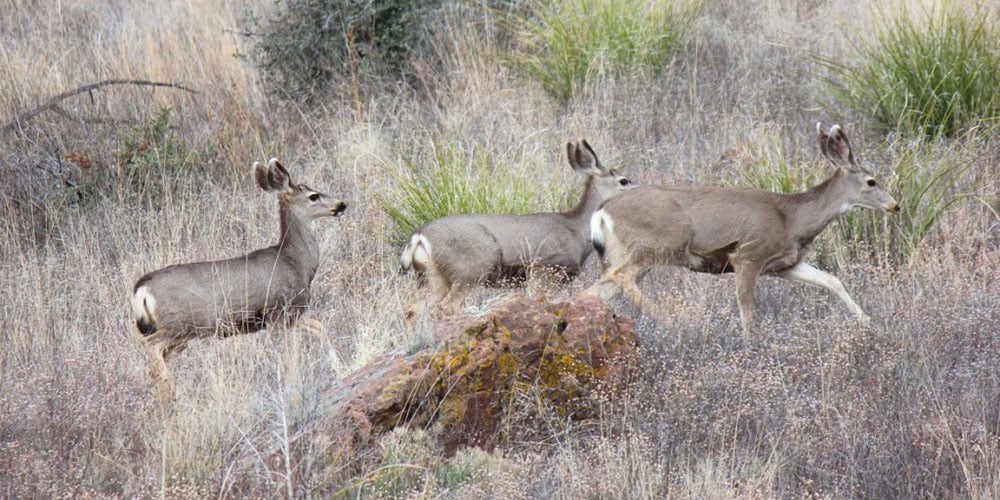

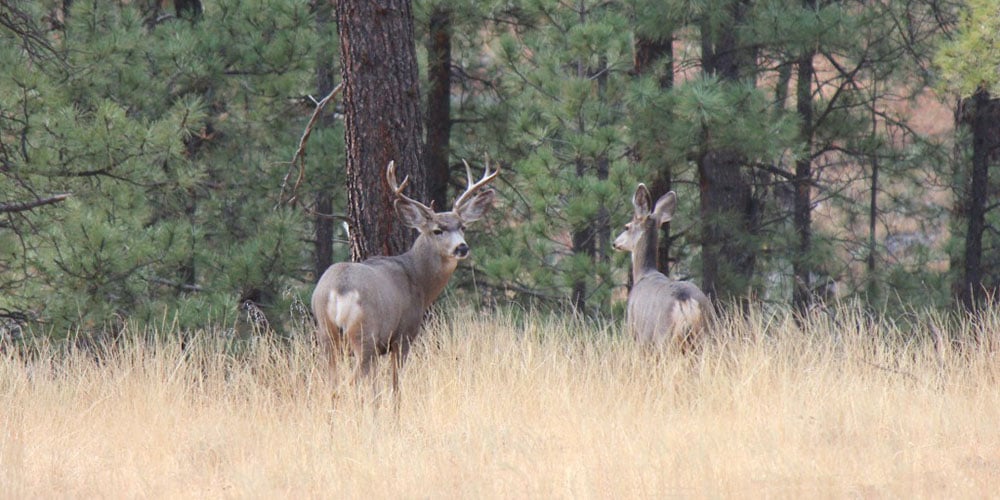
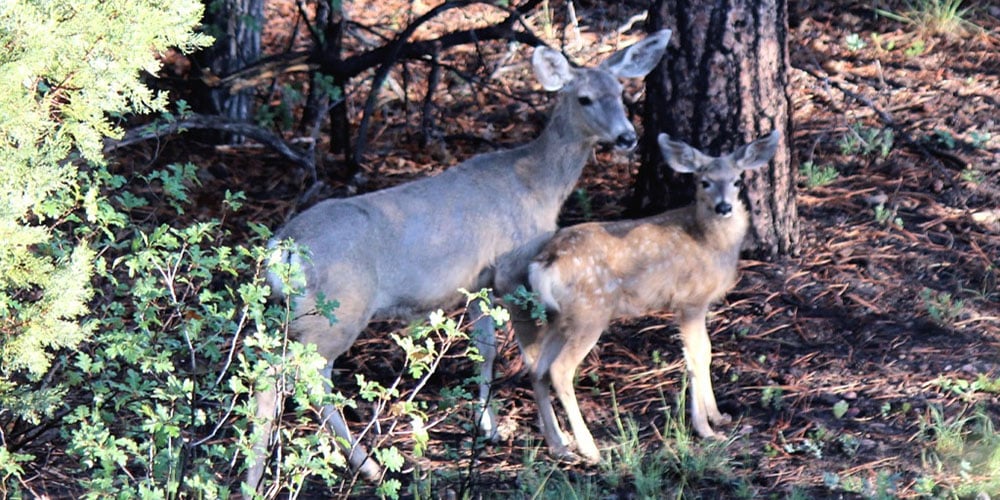
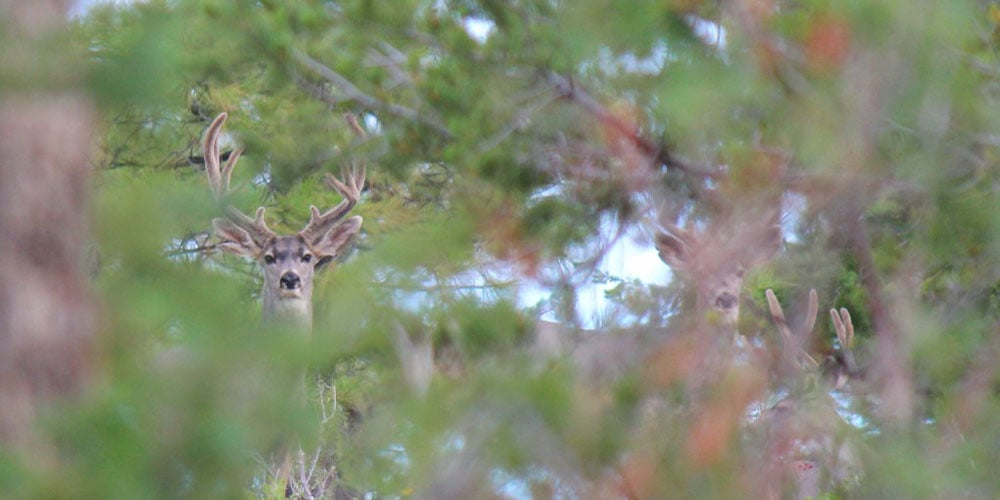
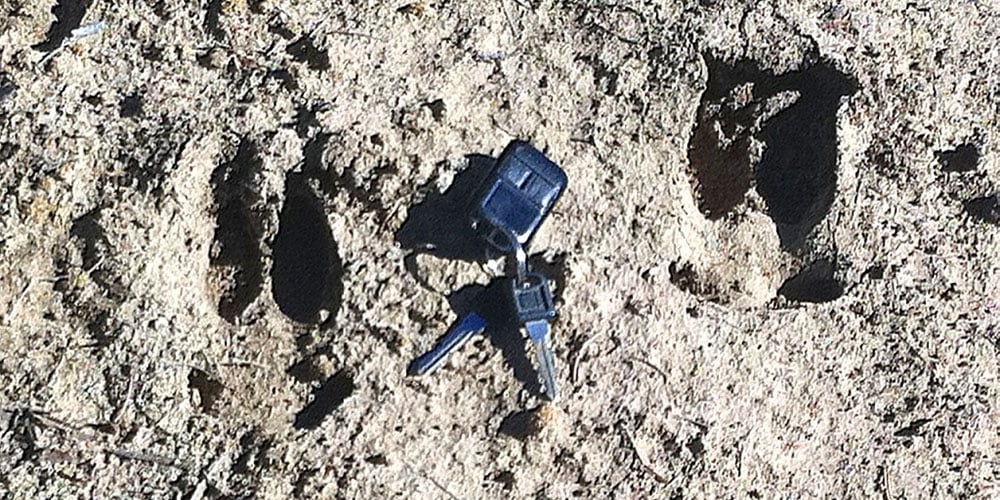
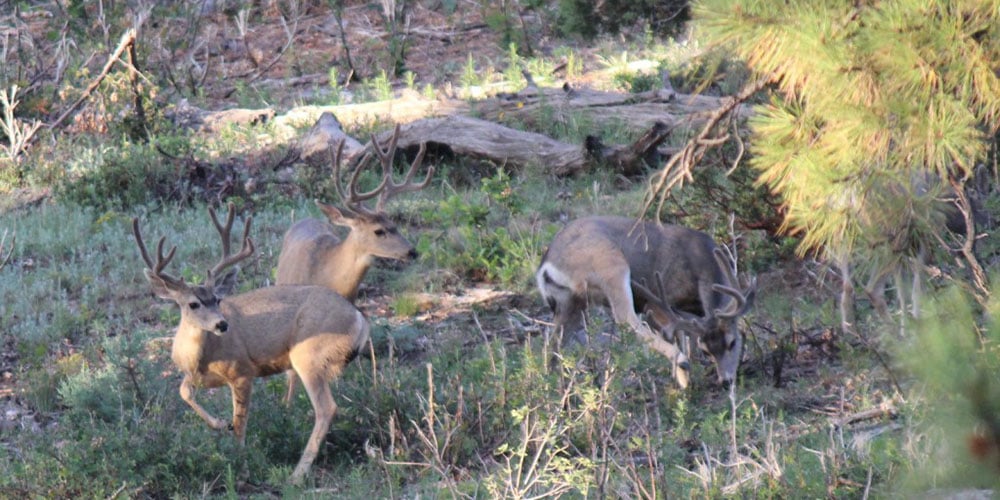




Leave a Reply